Dermatomycoses are common.They develop due to infections with anthropophilic and zoophilic fungi.You can become infected through personal contact in public baths and saunas, swimming pools and gyms.Fungal pathology has characteristic clinical manifestations, but not everyone knows what foot fungus looks like, so few seek medical help in the early stages.This helps the spread of infection.
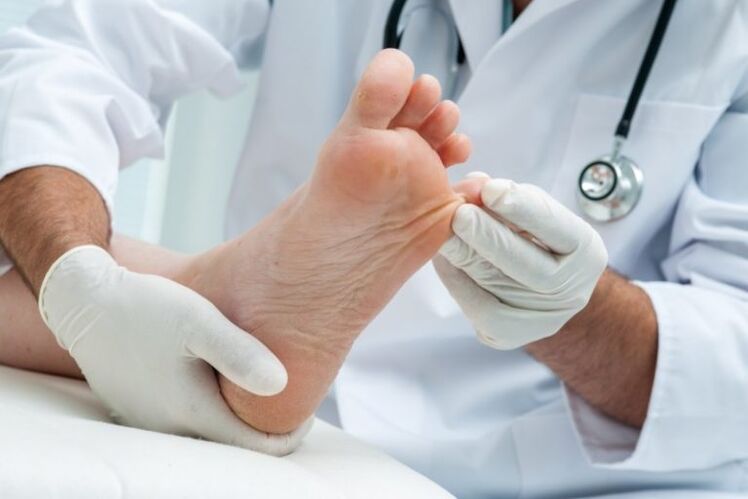
Symptoms of skin damage to toes
The first changes caused by fungal infections are difficult to notice: they do not cause pathological changes in the affected area and do not produce discomfort.With a strong immune system, an infection at this stage can resolve on its own; as the body's defenses weaken, it will progress and move on to the next stage.At this stage, a floury detachment forms in the interdigital area.The skin becomes red, dry, and cracked.This process is accompanied by severe itching.Feet and heels have a healthy appearance.
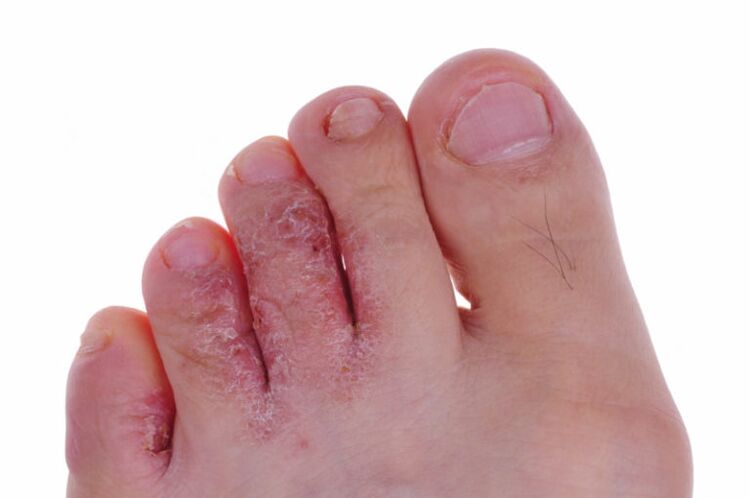
Symptoms of toenail fungal infection
Affected nails have a distinctive look, so it's not difficult to recognize the onset of infection.The pathological process develops according to:
- The nail plate thickens, its color changes: the pale pink color disappears, and a yellowish-gray color appears.
- A gap appears between the blank and the sheet.
- The nail plate gradually begins to peel and the edges become brittle.They collapse and gradually collapse.
- Severe itching occurs in the affected area.It distracts you from your daily activities.
- Irritation and redness of the skin between the fingers, followed by painful cracks.
- The affected area has an unpleasant sour smell.
Trimming your nails with regular nail clippers becomes difficult.They cannot be handled with a nail file or special tweezers: the plates will shatter.
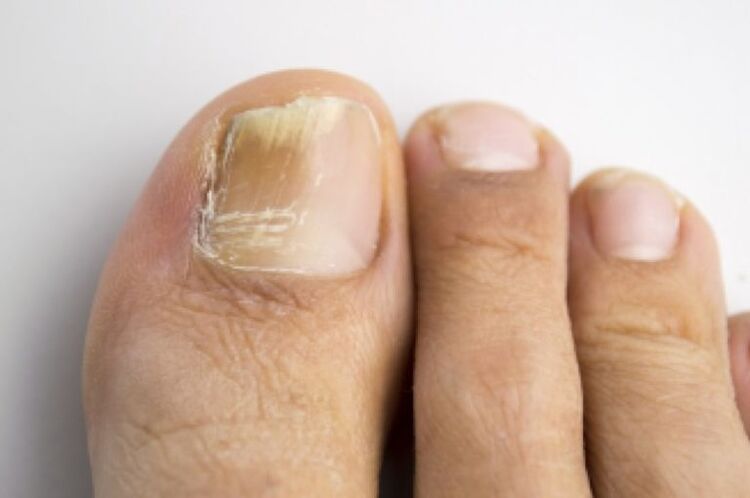
Symptoms of plantar fungus
Determining the symptoms of foot fungus on your own can be difficult.The development of the infection can lead to the formation of callus-like structures on the soles of the feet.The appearance of other symptoms is related to the progressive form of the disease.
It all starts with squamous morphology.At this stage, the infection can spread throughout the sole of the foot.The skin on it becomes rough and horny, begins to actively peel and itches severely.Externally, the feet look like the result of a lack of regular pedicures (unkempt).
Next, a form of hyperkeratosis occurs.During this process, a gray thickening will form on the arch.They have a lot of peeling around the edges.Deep cracks appeared where the calluses were.This process can cause severe pain.Doctors call this phenomenon "moccasin foot."If you look at the sole of the affected foot from above, there seems to be a thick yellow-gray insole stuck to it.The fungal infection spreads to the spaces between the fingers and to the nails.They can discolor, peel, and collapse.
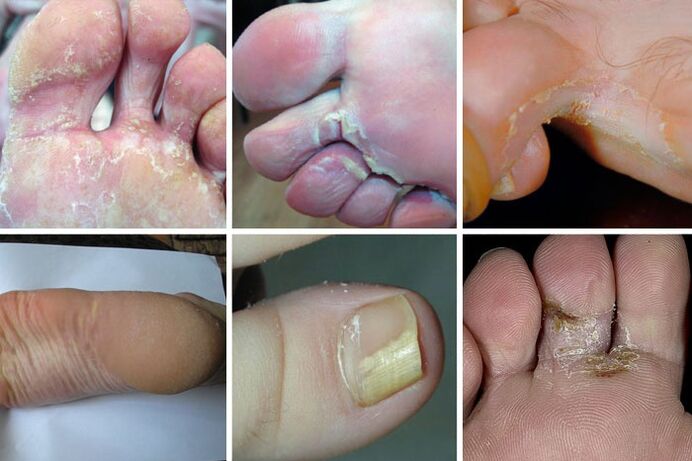
Sweating disorder form.It is characterized by the appearance of blisters filled with turbid fluid on the skin of the feet.This is only possible in advanced forms of infection.When the bubble bursts, leakage erosion will occur at its location and leakage will continue.Disease-causing bacteria can easily penetrate open wounds.Secondary infections significantly worsen the patient's condition; in this case, it is difficult to diagnose the fungal infection by external manifestations: the symptoms are similar to the clinical manifestations of eczema or psoriasis.
Fungal clinical symptoms by disease stage
It can take 3-14 days from the date of infection until the first symptoms appear.The duration of the incubation period depends largely on the type of fungus causing the development of characteristic symptoms (yeast-like, moldy or candida fungi) and on the state of the immune system.
During its development, fungal infections go through three stages:
- In the early stage, symptoms such as redness of the affected area, dry skin, and peeling will appear.Patients may experience mild itching.
- The intermediate stage is characterized by the spread of infection throughout the foot.
- In advanced forms, damage to the nail plate is observed, the skin of the feet is covered with cracks, and large layers of the cuticle are separated.
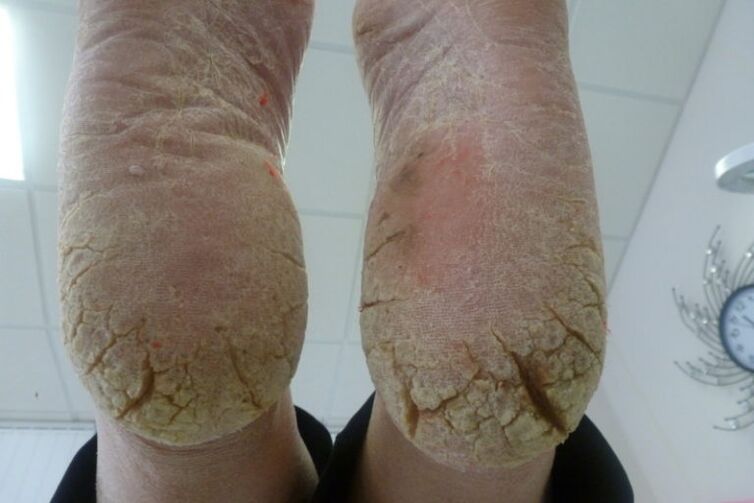
Without symptomatic treatment, the infection enters a chronic stage.It is characterized by alternating remissions and exacerbations.
Differential diagnosis
Diagnosis of the disease begins with an examination of the feet and a history taken by a dermatologist.Based on their results, doctors will perform additional laboratory tests.
What must be done:
- Scraping from the affected area and subsequent microscopic examination (with the help of which the fungal nature of the infection was confirmed).
- The extracted biological material is seeded into a special nutrient medium.Colonies of pathogenic microorganisms grown in this way can identify the causative agents of diseases and determine their susceptibility to modern antifungal drugs.Based on this laboratory test, a drug treatment plan is developed.
Fungal skin infections must be differentiated from vitiligo, seborrhea, psoriasis, syphilitic leukoderma, and neurodermatitis.For these purposes, skin examination under Wood's lamp and PCR are used.
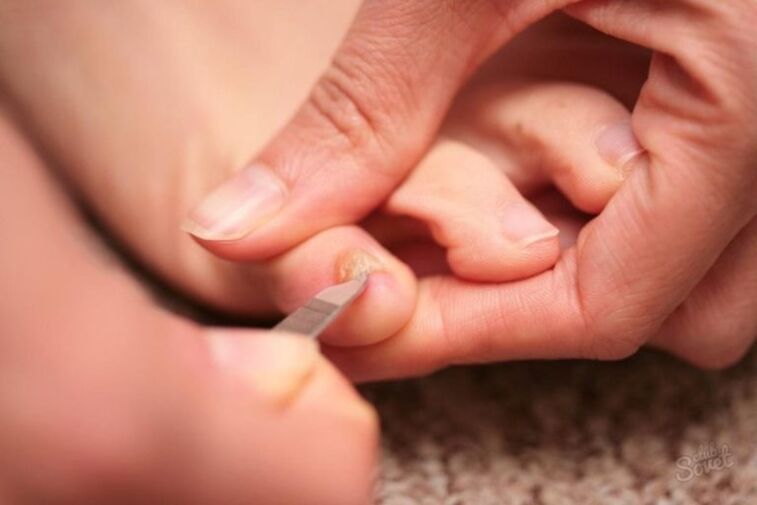
How to Fight Foot Fungus
To fight fungal infections, use the following methods:
- antifungal ointments;
- Antifungal agents in tablets;
- Traditional medicine.
Apply the ointment to the affected area twice a day; first, the skin of the foot must be steamed and the cuticles removed.The duration of taking the tablets is determined by the attending physician.Generally speaking, the course of treatment for the initial stage of infection does not exceed one month; advanced forms will be treated within six months.Traditional medicine can significantly speed up the healing process.Doctors advise patients to pay attention to the following recipes.
Take a bath with vinegar and hydrogen peroxide.Pour 37-degree water into a basin, add 20 grams of vinegar, and then put your feet in the water and warm them for twenty minutes.Afterwards, you need to exfoliate the cuticles with a pumice stone, dry your feet, and apply 3% hydrogen peroxide solution to the affected skin.At the end of the procedure, lubricate the affected area with an antifungal cream prescribed by your doctor.

Salt bath and celandine juice.The feet are pre-steamed in a salt solution (one teaspoon per liter of water) and then lubricated with celandine juice made from fresh leaves and grass stems.The process ends with the application of antifungal drugs.
A soda bath (20 grams of powder per two liters of water) can relieve inflammation and stimulate ulcer healing.Steam your feet for fifteen minutes, dry them with a towel, and apply an appropriate ointment.
Throughout the treatment process, it is important to thoroughly disinfect all surfaces (shoes, clothing, bedding) that come into contact with your sore feet.After handling the affected skin area, you must wash your hands thoroughly and then treat with any liquid disinfectant.Violation of the number and dosage of the drug taken will lead to an increase in the susceptibility of the pathogenic microflora, requiring prolonged treatment and some changes in tablets and ointments.
To prevent recurrence, it is important to prevent reinfection.Wear only dry shoes, choose socks made of natural fabrics, and use only personal pedicure accessories.

















